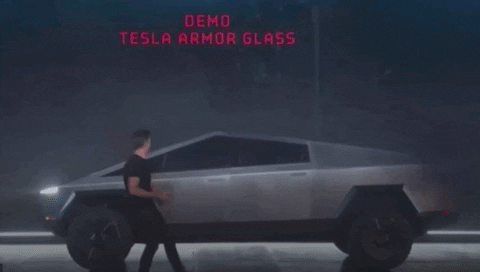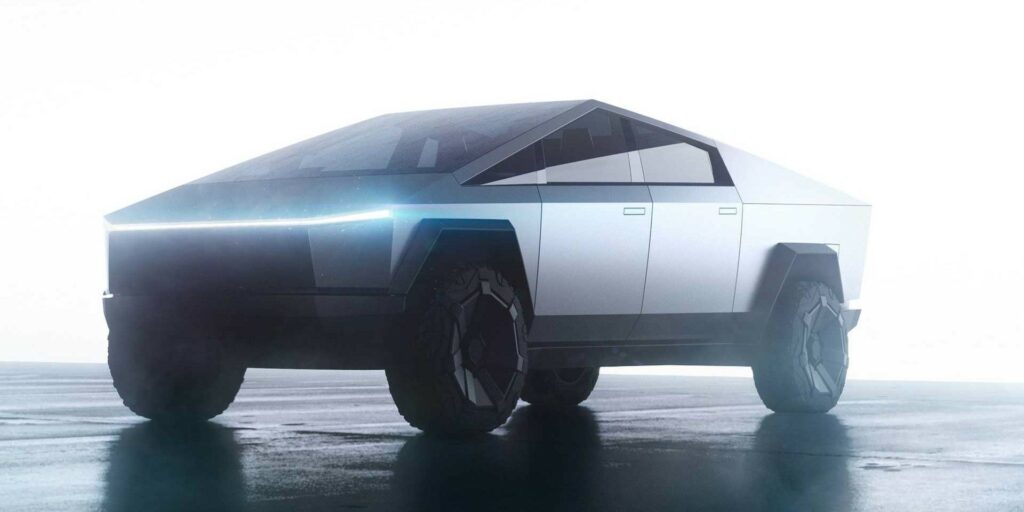Tesla's Cybertruck was celebrated for its '90s cyberpunk aesthetic, innovative EV technology, and "bulletproof" construction. But it's best remembered for its 2019 unveiling, when a Tesla employee attempting to demonstrate the truck’s bulletproof construction smashed two of the "Armor Glass" windows live on stage:

For context, you can watch the entire demo event on YouTube (here's CNET's recording of the event queued up to the Armor Glass demonstration). You'll see Musk describe the windows as "Armor Glass" and "transparent metal"—which certainly sound hearty.
But what is "transparent metal"? Is that the same as "transparent aluminum" (which is extremely strong)?
No. It seems more likely that what Musk is calling "transparent metal" is similar to borosilicate. Borosilicate is commonly used in lab glassware and older clear-glass baking dishes sold under the "Pyrex" trademark. It's about 3% metal. And borosilicate is indeed tougher than regular soda-lime glass. But it's rarely used in ballistic or blast-rated safety glazing.
What is Tesla Armor Glass Made of?
So then, what actually is "Armor Glass" (apart from clearly not bulletproof, or even shatter-proof)? Is it just a sheet of Pyrex with a tougher name?
No. In many ways, it's much more than that. According to patent documents, Tesla Armor Glass (aka "Durable Glass for Vehicle") is a two-ply laminated glass product:
"A multilayer glass stack for a vehicle windshield with improved durability …. The multilayer glass stack includes an external-facing glass layer, an internal-facing glass layer, and an adhesive interlayer positioned between the external-facing and internal-facing glass layers. The external-facing glass layer comprises borosilicate."
Most of the advantages listed in the patent are related to durability, although few have to do with blunt-force resistance (in fact, a steel-ball drop—similar to the Cybertruck demo—is a part of the standard UL 972 testing for "Standard for Burglary Resisting Glazing Material"). It seems to be designed to avoid scratches, pitting, and chipping—and to reduce thermal cycling in the glass, thus preventing "micro damage" (like chips and pits) from growing into cracks that would need repair.
Interestingly, the patent also lists "Additional advantages of such improved multilayer glass stacks include…greater technology integration into glass components." In other words, the possibility of directly integrating sensors or displays into the windshield of the vehicle—something of obvious interest to a technology-first auto manufacturer like Tesla (although they don't yet appear to have a problem in need of this solution).
Nowhere in the patent are "bullet", "ballistic", "blast", "armor", or "force" mentioned (apart from two brief notes that "external forces" and "forced contact with small gravel or sand" can damage standard auto glass).
No one at Tesla really thought the Cybertruck was "bulletproof" in any formal sense or "armored" against anything more than gravel and roadside debris.
You Need to Know What the Lab—Not the Marketing Team—Says About Bullet Resistance
So what went wrong with the 2019 demo? How did Tesla's lead designer end up standing in front of a huge sign that said "Armor Glass" and smashing a car that he himself designed?
In short: marketing got ahead of reality.
"This actually happens sort of a lot," according to Jim Richards, CEO of Total Security Solutions. Jim has decades of experience building bullet-resistant barriers for banks, businesses, government agencies, and other organizations using legitimate UL-rated ballistic materials. He sees two issues with situations like the "Armor Glass" debacle:
"First, a lot of stuff—like the aftermarket films or detention glazing layered with polycarbonate, or even un-rated polycarbonate—is really ‘shatter-proof.'"
"You can beat on it for hours with hammers and get nowhere," Jim says. "People see that, and it really is impressive. From there, they just assume that material is the end-all be-all and stops anything. And so for people outside this industry, it all just gets lumped together. People don't realize that it isn't just a matter of hitting it with a hammer or shooting it with a pistol, and saying 'the bullet didn't make it through, therefore it's bulletproof.' There are specific tests performed by recognized laboratories so that regardless of who you buy a rated bullet-resistant window from, or what it's made of, it stops the same number of bullets under the same conditions."
Pro-Tip: Bulletproofing Experts Don’t Say "Bulletproof"
The other issue is that words like "bulletproof" and "armor" are widely used in marketing simply to convey something works well or provides some sort of confidence boost. A cup of "bulletproof coffee" will pep you up, but it doesn't keep you safe during a stick-up. Under Armour™ is great when you’re running, but won't protect you while jousting.
As Musk himself explained in an interview after Jay Leno asked why Musk cares about whether or not Tesla's truck is bulletproof:
"Because it's bad-a** and supercool. … Do you want your truck to be 'bulletproof' or not?"
Jim, of course, is not an automotive glass expert—he's always worked on physical security for buildings. And he is quick to add that the Tesla Armor Glass patent is indeed interesting: some of the glass makeups described in their patent offer the possibility of better transparency, increased durability, integrated sensors, integrated displays, dynamic glass, and so on.
But Jim is an expert in ballistic materials. As a rule, he doesn't say anything is "bulletproof," just that it's "bullet-resistant" or "ballistically rated"—and he doesn't say that unless he's sure it will stop a bullet.
Want to learn more about real bulletproof glass? Download our free "8 Levels of Bullet-Resistant Glass" infographic. Curious about your options for securing your building? Talk to a TSS ballistic expert now.

